Window buying is complicated. Whether you are replacing existing windows or installing new ones, they are both equally confusing. As of this writing, in the United States alone, there are 648 windows manufacturer, 22 different types of windows encompassing more than 29 million windows listed on National Fenestration Rating Council’s (NFRC) website.
The traditional windows buying process for most people starts with searching for a local windows installer/dealer from Google, Yelp, Angie’s List, neighbors or local coupon books. Once one finds a dealer/installer, potential end-users are usually inundated with various Trademarked or Registered terms presented in many product brochures created by manufacturers, each claiming their “technology” is superior to other manufacturers in the market. Below are several examples of such terms:
- UniShield®
- Comfort-Gard® PLUS
- MAXEdge™
- ComforTech™ DLA-UV
It’s very hard for consumers to compare windows fairly because most manufacturers are smart enough to ensure their dealers do not overlap within specific areas. From buyers’ perspective, this translates into not being able to find the same brand of windows to do a fair comparison. With less competition, margin can remain healthy for both the manufacturers and dealers. Consumers however, get the shorter end of the stick.
This Windows Buying Guide attempts to address the challenge of buying residential windows by using data-driven strategy utilizing data provided by NFRC, combined with energy efficiency guidance issued by U.S. Environmental Protection Agency and U.S. Department of Energy.
“NFRC is a third-party non-profit organization that sponsors certified rating and labeling to help consumers compare the performance of windows, doors, and skylights. NFRC does not distinguish between “good” and “bad” windows, set minimum performance standards, or mandate performance levels. This is where ENERGY STAR comes in. ENERGY STAR enables consumers to easily identify NFRC-certified products with superior energy performance.”
ENERGYSTAR.GOV
The Guide is summarized in a flow chart below. When more detail is necessary, a clickable link is presented on top of each shape/step. You can download the flow chart here.
1. Available Window Types
Before you can compare windows from different manufacturers, you need to know first different kind of windows that are available. NFRC’s data dictionary also provides listing of different type of windows under Product Type Codes section. Different types of windows perform differently. For example, a picture window tend to be more efficient than a slider window. However, picture window is not openable. Know the pros and cons of a window type. Once the type of windows is known, the next step is to find the performance ratings.
3. Windows for Specific Climate Zone
Different geographic region has different climates. Therefore, the best windows for someone who lives in northern Michigan might not necessarily be the best for someone who lives in Miami, Florida. Each window has a performance criteria that is independently rated by NFRC. ENERGY STAR® prescribes the best performance criteria for windows with the intent to maximize energy usage.
ENERGY STAR® is a joint program of the Environmental Protection Agency (EPA) and the Department of Energy (DOE). Its goal is to help consumers, businesses, and industry save money and protect the environment through the adoption of energy-efficient products and practices.
energy.gov
Comparison of different windows manufacturers is made possible with performance data from NFRC and performance guidance from ENERGY STAR®. The guidance is summarized in the graphics below. To find what zone a house is, go to the climate zone finder website provided by ENERGY STAR®
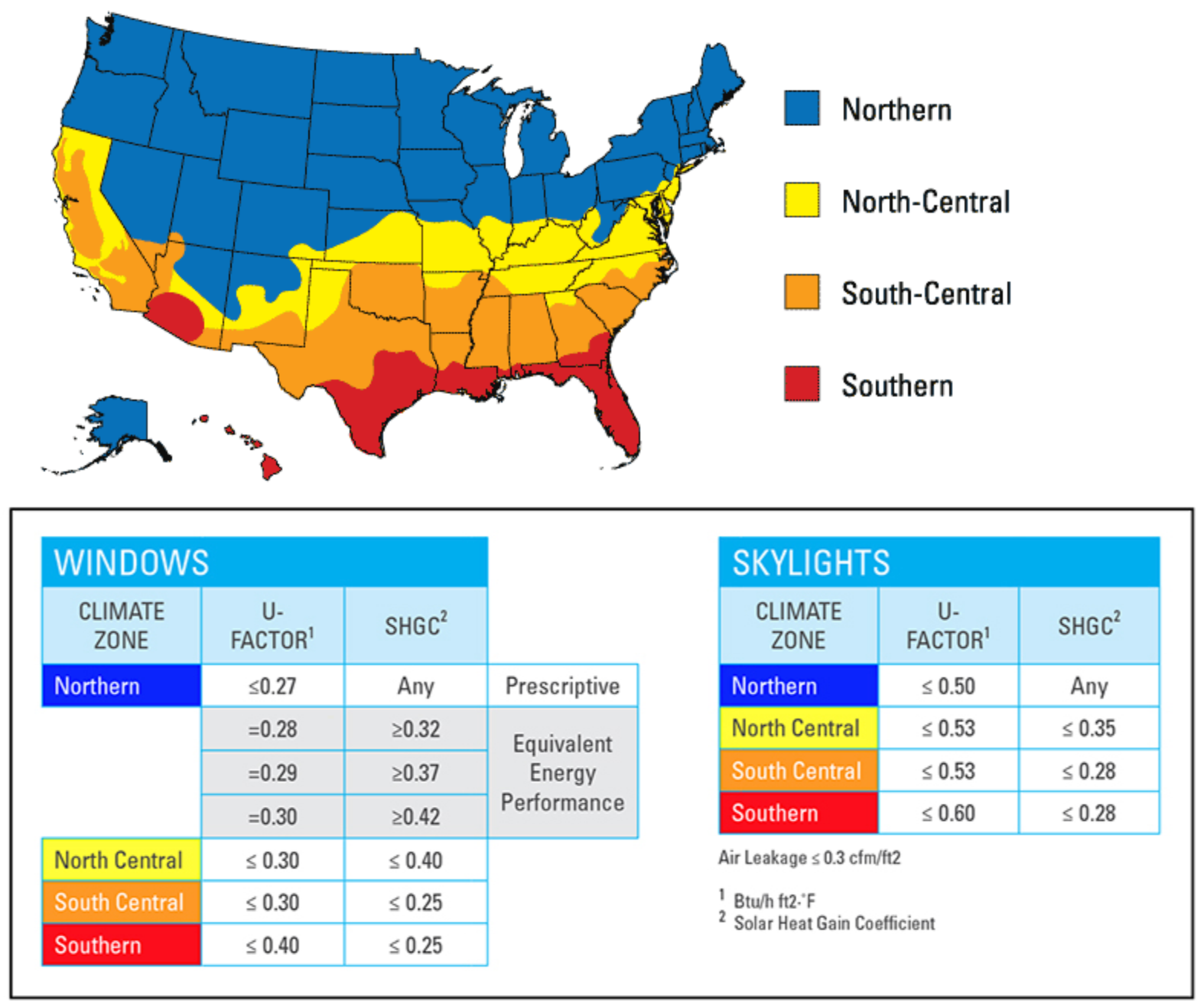
The two most important variables to use when comparing performance of two or more windows are U-Factor and SHGC. U-Factor measures how well a window prevents the loss of heat from inside a house. It ranges from 0.2 (the best) to 1.2 (the worst). It’s very similar to the R-value when buying fiberglass insulation. In fact, to get the R-value of a window you just divide 1 by the U-Factor. For example, the R-Value of a window with a U-Factor of 0.25 is 4 (1/0.25 = 4). This variable is particularly important for colder areas.
SHGC stands for Solar Heat Gain Coefficient. It measures how much the sun’s ultraviolet (UV) heat can pass through a window into a house. It ranges from 0 to 1. The closer the SHGC is to 0, the better a window is at preventing heat from the sun to enter through the window. A rating of 0.15 means the window will allow only 15% of the UV heat to enter through the window. This is particularly important for warmer areas or for windows that are facing east or west. Some manufacturer present this as a percentage of ultraviolet blocked, which is the inverse of NFRC rating for SHGC, but has the same meaning. For example, instead of specifying SHGC rating of 0.15, some manufacturers will mention a window that is able to block 85% of UV heat.
The 2 performance criteria (i.e. U-Factor and SHGC) specified by ENERGY STAR is the Minimum Acceptable Rating for windows one is planning to buy. Armed with the knowledge of these 2 variables, one should be able to fairly compare the energy performance of a window type made by different windows manufacturers and ignore all the marketing terms presented by dealers/manufacturers. In other words, for every window one is considering, pick the one with the best Minimum Acceptable Ratings. Combine the ratings with reasonable pricing and an installer’s reputation to come to a final selection of a brand.
4. Window Orientation
If your window is directly facing sunlight(i.e. east or west), to maximize energy savings, Department of Energy recommends windows with lower SHGC, regardless of the climate you are in. Refer to the reference table below from Department of Energy Guide.
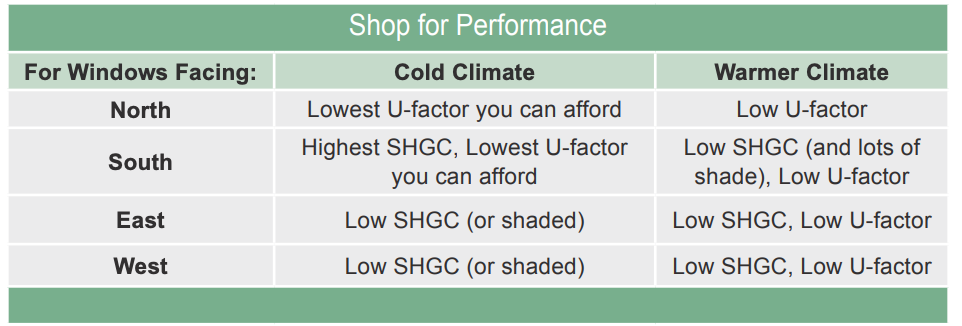
5. The Data Scientist Way
The Data Scientist way is a more convoluted way to narrow down the best possible windows. However, it is very comprehensive. It entails obtaining a list of all windows manufacturers and types from NFRC website, followed by filtering out most of the windows that do not meet the end-user’s Minimum Acceptable Rating defined in step 3 and 4 above. The final result is a listing of all manufacturers that are available locally for the end-user. This requires processing and filtering about 29 million rows of windows data. Source code will be provided in Step 6 below.
Chances are most people are not data scientist, and it is completely okay to follow through the laymen route. One might not be able to obtain a list of comprehensive windows manufacturers, but the basis of comparison of windows performance is still the same. The author attempted both ways of buying windows (i.e the data scientist and the laymen methods), and came to the same choice of a brand by chance.
6. Find Available Windows in Your Area
If obtaining a comprehensive list of manufacturers is not feasible, start with local dealers to find out the brand of windows they offer. Please note that at this point, no comparison is made yet. One simply has specifications of windows performance that meet his/her Minimum Acceptable Ratings (i.e. U-Factor and SHGC ratings). The next step is to find out different brand of windows that are available locally. This can be accomplished by calling local windows dealer(s).
When contacting a dealer, don’t ask for a quote yet. At this point, the goal is to find out whether the dealer carry windows that meet the Minimum Acceptable Rating. If they don’t carry such windows, asking for a quote is just a waste of everyone’s time. Clearly specify to the dealer the expected Minimum Acceptable ratings and the window type. Keep in mind that most dealers won’t know the exact ratings of a window until they look it up. Alternatively, one can simply ask the dealer for the manufacturer’s name and look up the performance rating from the manufacturer’s website or the NFRC website .
To stifle competition, most manufacturer won’t have the same brand carried by more than one dealer within the same zip code. Make sure the manufacturer’s name can be found on NFRC website. If the manufacturer’s name is not on NFRC website, ask the dealer for the name as appeared on NFRC label for the windows they are selling. Do NOT ask for a quote yet. A couple of real example are given below:
- There is only 1 dealer selling a SUNRISE® Windows servicing the author’s zip code. However, there are different dealers carrying vanguard® windows and RESTORATIONS® windows servicing the same zip code. They are different brands, but they are technically coming from the same manufacturer (i.e. Sunrise Windows).
- After calling Universal Windows Direct© the author found out that the company name is not listed on NFRC website, but after asking the dealer, the manufacturer turns out to be Polaris© Windows.
7. Finding Windows’ Performance Ratings of Windows
Once the list of locally available brands is compiled, the next step is to find whether the manufacturer carry windows that meet the Minimum Acceptable Ratings. Start with the manufacturer’s website. Some manufacturers are better than others when it comes to listing the energy performance metrics for their windows. Spend 5 to 10 minutes browsing for the performance metrics. If the performance metric is not easily found, try googling the brand. For example, for Polaris windows, try googling for Polaris thermal performance. If performance metrics are not available on the manufacturer’s website, NFRC website can be used to find if the manufacturer carry a specific type of windows that meets the Minimum Acceptable ratings.
For every product line of a window, there is a CPD number. If CPD numbers are available on the manufacturer’s website, take note of them. It will be useful when obtaining a quote from dealers. A CPD (Certified Product Directory) number is a unique number assigned to every window type produced by a manufacturer. It shows consumer detailed information about a window (e.g. a product line, window type and the performance metrics of a window). With a CPD number, performance metric of a window can be easily found on NFRC website, making comparison between 2 or more manufacturers easy to do. However, most manufacturers do not have CPD number listed on their sites, but they will have their performance rating listed. Take notes of the product line, the glass package and the performance metric. They will come in handy when asking for a quote from a dealer. Below is a sample of NFRC performance label displaying performance ratings of a window. 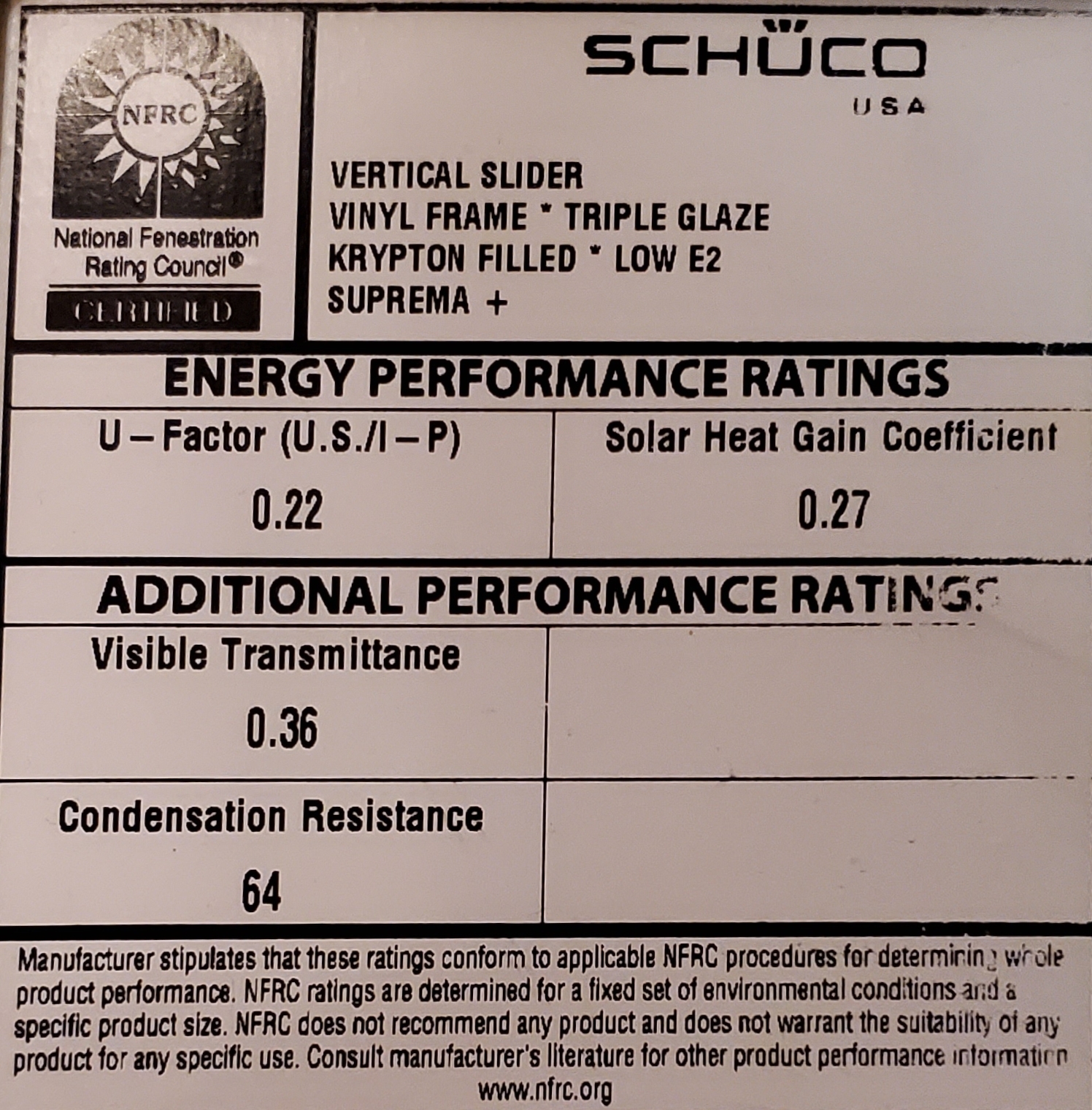
9. Reputable Manufacturer
A lot of windows come with lifetime warranty. Some are transferable to the next owner. However, not all warranty is created equal and a warranty is only as good as a manufacturer’s ability to stay in business. It is better to focus more on the reputation of a company than the length of the warranty they offer. Once a company exits a market (e.g. declares bankruptcy or acquired by another company), it is no longer responsible to honor any warranty. A good example of this is Schüco, a reputable German company that used to sell windows in the U.S. market. The author happens to inherit Schüco windows from the previous homeowner. However, at the time of this writing, the company has exited the U.S. market, rendering all the warranties for the windows it sold worthless. Another example would be a story of Gorell Windows company that went bankrupt in 2012 and ceased to honor its warranty.
There is really no way to foresee whether or not a company will still be around 5-10 years from now. However, reputable companies that’s been around for some time tend to have less chance of going out of business and more chance of being able to honor the warranty they issued.
A sample of 78 window companies without any history of bankruptcy was taken. They all have been in business for a median of 42 years (This sample is obtained from obtained from National Glass Associations’ Top 100 Window and Door Manufacturer by including only companies that offer window products). On the other hand, a sample of 27 windows companies that have track records of not honoring warranty due to bankruptcy or acquisition has a median lifespan of 19 years. 63% of them (16 out of 27) operated less than 25 years before they stopped honoring warranty. The distribution of warranty-honoring and non-warranty honoring companies are pictured below along with the list of 27 companies that have a history of not honoring warranty.
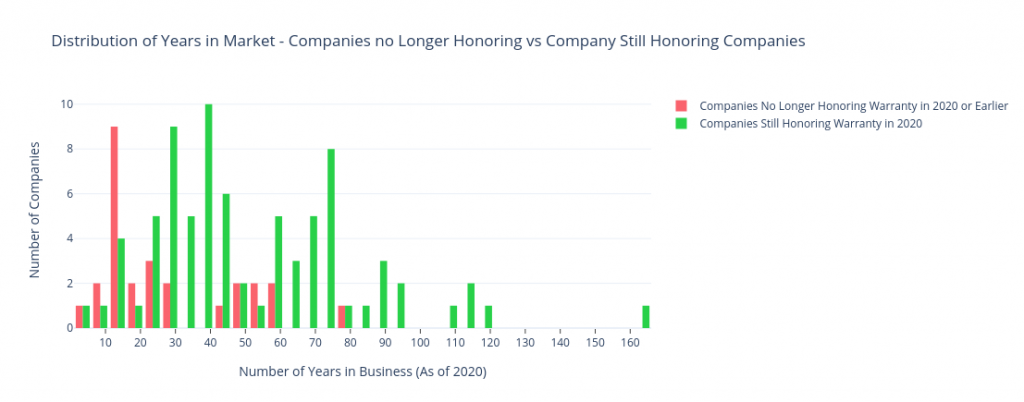
| Company Name | Years in Business |
| Serious Window | 3 |
| Maritech Windows | 7 |
| Schuco | 10 |
| Empire Window Inc. | 11 |
| Exclusive Doors and Windows | 11 |
| Accuweld | 13 |
| Echo Windows | 14 |
| Paramount Windows | 14 |
| Atrium Windows and Doors Inc. | 15 |
| Practical Windows and Doors Inc. | 15 |
| Kensington Windows | 15 |
| Jancor Cos. Inc. | 15 |
| Vista Window Company | 19 |
| Gorell Windows & Doors LLC | 19 |
| Weathervane Wood Windows | 21 |
| BMC | 22 |
| Vinyl Window Technologies, Inc. | 23 |
| Accent Windows, Inc | 26 |
| Acan Windows | 29 |
| Republic Windows and Doors | 43 |
| LBL window | 46 |
| Jordan Co. | 49 |
| Hurd Windows and Doors Inc. | 51 |
| IWC Window | 54 |
| Thermal Windows and Doors | 60 |
| B.F. Rich Windows & Doors | 60 |
| Semco Windows And Doors | 78 |
According to The International Association of Certified Home Inspectors – InterNACHI®, vinyl/fiberglass windows last between 20 to 40 years, depending on the materials used, climate, utilization, and, installation. Looking at the samples, disreputable companies do not seem to last far beyond the minimum life expectancy of the windows they make.
It’s very important to understand the risk of picking a window manufacturer. New companies that have not been around for a while are risky. They might cost less upfront, but the quality of their windows aren’t tested. On the other hand, the longer a window manufacturer has been around, the less likely (but not impossible) they are to be out of business. However, there is a price premium for such companies (e.g. Pella, Anderson, etc). The author compares a quote from Pella windows to other manufacturers and found out that Pella windows costs roughly 3 times as much as other manufacturers.
Evaluating the sample of the 27 companies listed above, combined with the minimum life expectancy of a vinyl window, a manufacturer that’s been around for at least 25 years or more seems to have a good balance between cost and risk. This number can be adjusted lower if one is willing to take on more risk of not being able to claim a warranty in the future.
Searching for the manufacturer on the list of websites below is helpful to determine how reputable a manufacturer is.
- Google, by typing in the company name followed by bankruptcy
- Houzz.com
- TheWindowDog.com. The article they have on Window Sales Tactic is also very expensive and worth a read.
- ReplacementWindowsReviews.co
- DWMmag.com
- Better Business Bureau®
10. Getting Quotes
At this point, one should know the window type to be installed, the Minimum Acceptable Ratings (e.g. U-Factor, SHGC) for each window and the locally available brands from local dealers in the area. It should be very straightforward to get a quote from a dealer.
The next step is to find an authorized dealer. It is important for the dealer to be an authorized dealer to make sure that window installation is properly done per manufacturer’s instruction without avoiding any warranty. The fact that a dealer carry a specific brand doesn’t necessary warrant that the dealer is an authorized dealer. The easiest way is to go to the manufacturer’s website and locate an authorized dealer in your area.
Contact the authorized dealer listed on the manufacturer’s website and ask for a quote. If a CPD number from the manufacturer’s website is available, provide the specific CPD number for the dealer. Otherwise, provide the dealer with the product line, glass package and performance specification of the windows. Tell the dealers that only windows that meet or exceed the Minimum Acceptable Ratings will be considered. Most dealers would want to come and take the measurement themselves and check if the installation would require more work/materials compared to regular windows installation.
Triple-Paned Windows
Triple-paned/glazed windows are windows with 3 layers of glasses in them. Most of them comes with 2 layer of Argon/Krypton gas between the glasses. They do provide better performance/insulation (i.e. U-Factor), but come at higher price compared to double-paned windows. The question most people ask is: Is it worth the extra cost?
This section will compare triple-paned windows with double-paned windows based on how long it will take to recoup the cost of upgrade through annual energy savings. In other words, if it cost $200 to upgrade from double-paned windows to triple-paned ones, but the upgrade results in $100/year in energy bill, the breakeven point of the initial upgrade cost is 2 years. The initial investment can be considered worth the cost because after the second year the triple-paned windows will result in lower energy bill. However if it takes 20 years to recoup the cost of upgrading to triple-paned windows, it won’t make financial sense to upgrade.
Below is a simple calculator that calculates the breakeven point of upgrading to triple-paned windows. This calculator will calculate:
- Annual heat loss through all windows in a house based on windows size
- Annual cost of the heat loss based on heat source and cost per unit of energy to generate heat
- Break-even point (in years)
Several things that are required for this calculator to work properly
- Heating Degree Days (HDD)
It is a number used to quantify the need to heat a house based on average temperature outside. The higher the number, the more heat is required to heat the house. When a state is provided in the drop-down menu, HDD from 2019 will be used automatically. This calculator assume constant HDD throughout the years. Alternatively, You can also input this number manually - Number of windows
For simplicity sake, this calculator assumes a uniform windows size and performance rating throughout the house. If this is not the case, calculate different measurement and performance rating separately and add up the results manually. - U-Factor for both double and triple-paned windows
- Total cost of upgrade to triple-paned windows
This is the total cost of upgrade for all windows to be installed, not the total cost of each window. For example, if there are 2 window types in a house, use this calculator twice (i.e once for each window type). - A copy of the most recent heating bill.
To find out how much heat lost through the windows cost annually, cost per unit of energy is required. This is usually stated on a utility bill.
Utilities companies charge their customer differently. Very rarely does a utility company have a single number of $/unit of energy. A sample utility bill can be seen below showing a total charge of $0.516/CCF.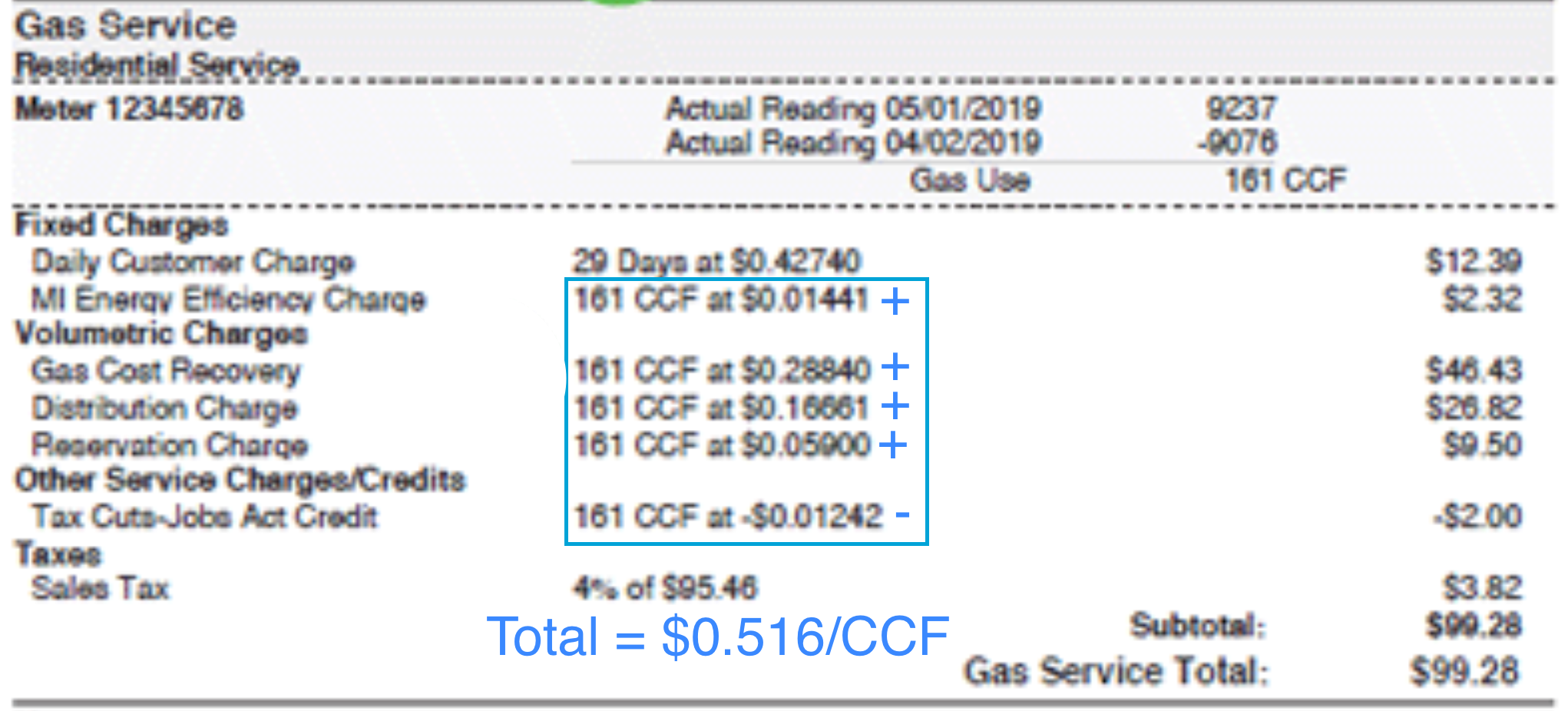
Frequently there are multiple charges to deliver energy to a house (e.g. distribution charge, usage charge, reservation charge, transmission charge, etc). They are usually billed per unit of energy used. For natural gas bill, they are usually billed per Therm or per CCF. For electricity, they are billed per KWH. Make sure to add up all of these charges on the utility bill (e.g. per CCF, per Therm or per KWH) and put the total in the calculator. If natural gas is charged per Therm, there should be a Therm/Thermal factor specified in the bill. This calculator does not take into account charges that are not based on usage (e.g. service charge, pass-through charge, customer service charge, etc.).
Break-even Point Calculator for Triple-Paned Windows
11. Finding a Reputable Dealer
A reputable installer is as important as a reputable manufacturer. Quality labors hardly come at a bargain. Good performing windows in the hands of unqualified installers are practically the same as poor performing windows. In fact, some manufacturers will refuse to honor warranty when their windows are improperly installed. Several things to keep in mind when looking for a dealer/installer.
- Make sure the dealer is an authorized dealer from the manufacturer
- Make sure the dealer has good reviews online (e.g. BBB, Yelp, Google) and has been doing business for sometime. It is hard to recommend the minimum number of years a dealer has to be in business for because bankruptcy data for small local window dealers is hard to come by. The author picked an authorized dealer that’s been in business for 22 years.
- Make sure the reviews are about windows. Some companies are involved in a lot of trades (e.g. gutter, sidings or roofing installation). They might have fabulous reviews for gutter installation, but if they don’t have many reviews on windows installation, it’s best to avoid such dealer.
- Make sure the installers are not contractors hired by the dealers. Simply ask the dealer whether the installers are in-house and/or factory trained. One of the quotes obtained by the author cost close to $1,000 less for comparable windows, but the dealer mentioned that the installation won’t be done by an in-house personnel. This might void a manufacturer’s warranty if problem arises in the future and the manufacturer deems the windows are improperly installed.
12. Comparing Quotes and Signing the Contract
At this point everything should be in order to make an informed decision:
- A list of comparable options of windows from different manufacturers along with their performance rating (e.g. U-Factor, SHGC, VT, Condensation Rating)
- Quote from different reputable dealers
A lot of times a process of elimination can be performed by judging how a salesman present him/herself. However, this post will only focus on quantitative data gained from the dealers and windows they offer. The next step is to remove outliers from all the available quotes. That translates into removing the cheapest and most expensive quotes. Quality windows and installation should not come at ridiculously cheap or expensive price.
Pick the best performing windows (i.e. using U-Factor and SHGC) that come from the most reputable manufacturer and installer on the list. When comparing windows from different manufacturer, make sure to compare windows with the same or similar U-Factor. A 0.01 or 0.02 difference (e.g. A window with 0.23 U-Factor from Brand X and a window with 0.21 factor from Brand Y) is considered comparable, while a 0.07 difference in U-factor won’t be considered similar. The calculator above can be used to see the amount of money wasted through heat loss for 2 different U-Factors. The amount paid for heat loss annually should be similar for similar windows.
If more than 2 vendors are still available after using the criteria above, pick one or more criteria below to arrive at a final choice:
- Visible Transmission
One of NFRC metrics that measures how much sunlight is allowed through the window. The higher the number, the more light is allowed in through the window, making the room brighter. - Condensation Rating
One of NFRC metrics that measures how well a window resist condensation. The higher the number, the better it is for the window to resist condensation. - Warranty
Understand what’s covered by the warranty. Most warranty does not include labor in the term. Pick what’s most important for you.
Once a final choice is narrowed down, make sure the glass package or the performance rating is included in the contract. As an example, below are a list of quotes obtained by the author for the four windows that meet the author’s Minimum Acceptable Ratings. The final two candidates are highlighted.
- PlyGem: $1,614.92 + $1,000 installation
- Polaris: $3,300
- Sunrise: $3,400
- ProVia: $3,850
- Vanguard: $4,600
- Stanek: $5,737.07
- Pella: $11,046.32
Pella’s price was unreasonably high. This is clearly an outlier at the higher end. Although the windows do meet the author’s desired Minimum Acceptable Ratings, windows from other manufacturers with better performance were available at lower price.
PlyGem offered a very attractive pricing. The quotes included two triple-paned windows and two double-paned windows. This is clearly an outlier at the lower end because other quotes comprised only of double-paned windows. Although the number looked really good, the dealer mentioned that the installation will be contracted out. Upon arrival to take measurements, the installer appeared to be a guy with a truck, with no company to be associated with. For future warranty purpose, the author decided to exclude this brand.
Polaris Windows was excluded because the author is willing to pay slightly more for windows with better U-Factor.
Stanek was excluded for the same reason as Pella. There are other windows with better performance rating and lower price point.
Vanguard was excluded because they are practically the same windows as Sunrise, marketed under different brand with extra bells and whistles that adds to the price point without any performance(i.e. U-Factor) gain.
The final two products being considered were ProVia and Sunrise. ProVia has slightly better U-Factor (0.23) compared to that from Sunrise (0.25). Several deciding factor that makes Sunrise the final choice is as follow:
- Sunrise has better VT rating, allowing more lights to get into the room
- The ProVia dealer has been in business for less than 5 years
- Most positive reviews about the ProVia dealer are not for windows.
13. Compiling Windows Data
There are 2 ways to obtain the list of window manufacturers available locally. The first is described in step 6 above, where one starts by calling local dealers. While the approach described in step 6 above is simpler and works just fine for someone who isn’t a data scientist, the list of manufacturers obtained this way might not be comprehensive.
The second way to obtain a list of manufacturer involves compiling windows data from all windows manufacturers on NFRC website. This step is highly technical and intended for someone who is familiar with Python programming language. There are 2 initial steps to accomplish this task:
- Compile all the windows data from NFRC website.
The code and its minimal documentation is available here. The code was working when the author was working on compiling the data. However, NFRC introduced captcha soon after, which made the automation difficult, but not impossible by tweaking the existing code above. - Store all the windows data in a query-able system such as RDBMS, MongoDB, Spark, etc.
14. Finding Windows
Once all the data is stored in a queryable system, filter the data to get a list of windows that meet the Minimum Acceptable Rating. Make use of the data dictionary provided by NFRC to narrow down each specific feature of windows (e.g. Gap Fill, Gap Width, Frame Type, etc). Below is description of several fields that are not included in the data dictionary:
- Glazing Layers
The number of glass(es) in a window. For double-paned window and triple-paned windows, the value will be 2 and 3 respectively - Low-E
Low-E is a coating on a glass surface. The purpose of this coating is to prevent heat from coming into (or escaping from) the house.
This field is not a numeric field. It consists of multiple information:- The first number indicates the emissivity rating. The emissivity rating is a number from 0 to 1, indicating how well the window absorb heat. For thermal performance of a window, the closer this number is to 0, the more energy efficient the window is. This is related to SHGC performance rating of a window
- The second number, enclosed within a pair of parentheses, indicates the glass surface with Low-E coating. For a double-paned glass and triple-paned glass, there are 4 and 6 possible positions respectively. Refer to the following images below.
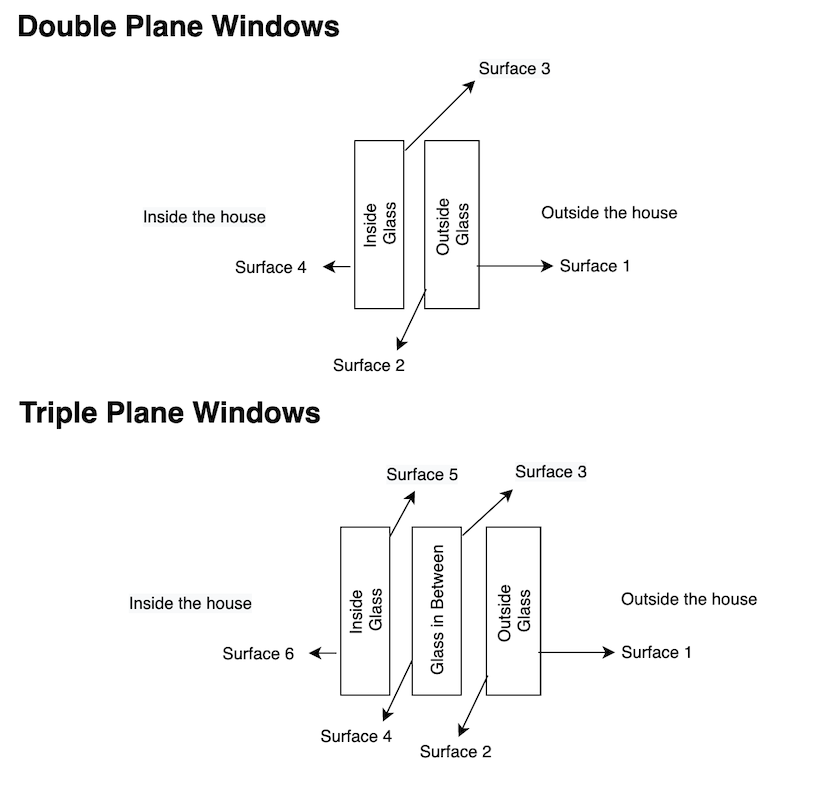
The number of Low-E coating layer and its location affect U-Factor of a window as well. When the coating is placed on the interior surface of a window(i.e. the 4th layer for double-paned window and the 6th layer for triple-paned), it increases the insulation rating of the window, making the interior more comfortable during winter times.
- Multiple occurences of emissivity rating and layer number indicates multiple Low-E coating in a window. For instance, the value of 0.022(2) 0.149(4) on a double-paned window indicates that Low-E coatings are on the second and fourth surface respectively.
- Gap-Width
The width of the space separating two glasses in inches. This field is not a numeric field. For a double-paned window, there is only a single gap-width. For a triple-paned window, there are two gap-widths, separated by a space. Research shows that the wider the gap between two glasses, the better they are at insulating a room. For colder climate, the author of the paper suggested optimal width between 0.59 to 0.71 inches. - Gap-Fill
The substance used to fill the gap(s) between glass layers in a window. The gap between two or more layers of glasses can be filled with: air, Argon gas or Krypton gas. Argon insulates a window better than air and Krypton insulates better than Argon, but it’s more expensive. For a double-paned glass, there is only 1 value in this field, which is the substance used followed by the quantity of the substance used to fill the gap. For a triple-paned glass there are 2 values in this field. For example:- Fill 1: Air(100)
This means the gap in a double-paned window is all filled with air. - Fill 1: ARG/AIR(90/10)
This means the gap in a double-paned window is filled with 90% Argon gas and 10% air. - Fill 1: KRY/AIR (90/10) Fill 2: KRY/AIR (90/10)
This means both gaps in a triple-paned window are filled with 90% Krypton gas and 10% air.
- Fill 1: Air(100)